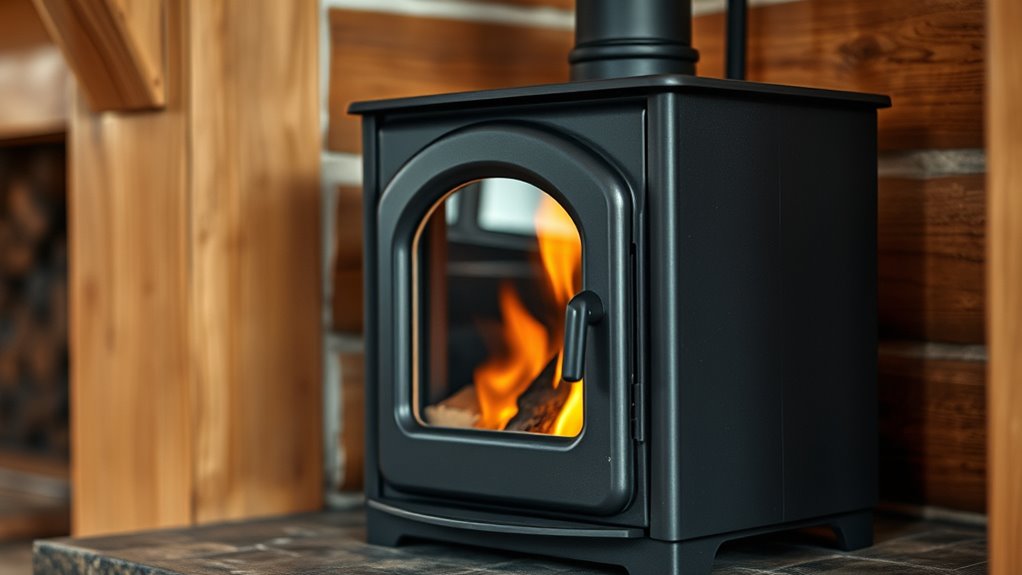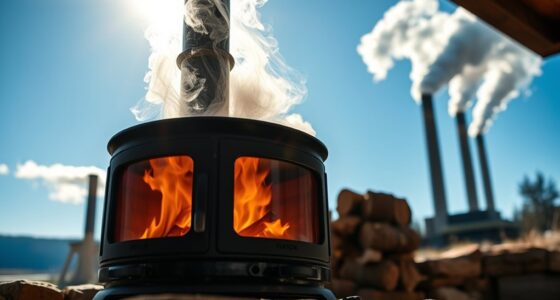To determine the right size small wood stove for your room, consider its square footage—most small stoves, with 1 to 3 cubic feet fireboxes, comfortably heat spaces up to around 800 square feet. Make sure your space has proper ventilation and follow safety clearance guidelines to prevent hazards. If you keep these factors in mind, you’ll find the perfect fit. Stay tuned to learn more about choosing and installing the best stove for your needs.
Key Takeaways
- Determine your room size in square feet to match with an appropriately sized stove (typically 1.5-3 cu ft for up to 800 sq ft).
- Ensure the stove’s heating capacity aligns with your room’s insulation, climate, and desired warmth level.
- Follow safety clearance guidelines to maintain proper distance from combustible materials and vents.
- Consider ventilation requirements to prevent smoke or carbon monoxide buildup for safe operation.
- Consult with a professional installer to select the correct stove size and ensure compliance with safety standards.

Are you looking for a small wood stove that fits perfectly in your space without sacrificing heating efficiency? Choosing the right size isn’t just about compactness; it’s about guaranteeing your room heats effectively and safely. To do that, you need to consider both the stove’s size and the specific ventilation requirements. Proper ventilation is vital to prevent dangerous buildup of smoke or carbon monoxide, so ensure your installation adheres to local codes and manufacturer instructions. Check that your room has sufficient airflow and that the stove’s venting system is correctly set up to avoid any hazards.
Safety clearance guidelines are equally important when selecting a small wood stove. These guidelines specify the minimum distance you must keep between the stove and combustible materials like walls, furniture, or drapes. Ignoring these clearances can lead to overheating and increase the risk of fire. When measuring your space, factor in these safety margins to guarantee your stove fits comfortably without compromising safety. Many small stoves come with manufacturer-recommended clearance distances—be sure to follow them precisely. If your room has limited space, look for models designed with safety in mind, often featuring built-in heat shields or protective panels that reduce clearance requirements.
Next, think about the heating capacity you need. Small stoves typically range from 1 to 3 cubic feet in firebox volume, suitable for rooms up to about 800 square feet. To determine what size you need, measure your room’s square footage accurately. A general rule of thumb is that a small stove with around 1.5 cubic feet of firebox capacity can comfortably heat spaces of approximately 400 to 600 square feet, depending on insulation and climate. If your room is smaller, a stove with a lower capacity will suffice; for larger rooms, consider a slightly bigger model within the small stove category to guarantee efficient heating without overworking the unit. Additionally, understanding the appropriate sizing ensures optimal energy use and safety.
Also, consider the layout of your room and the placement options. A smaller stove allows more flexibility in positioning, but make sure the location still respects ventilation requirements and safety clearance guidelines. This way, you avoid any obstructions to airflow and maintain a safe distance from combustible surfaces. Remember, the goal is to balance size, safety, and efficiency. Properly considering room layout can help maximize heating performance while maintaining safety standards. It is also advisable to install safety devices, such as smoke and carbon monoxide detectors, which are essential for your safety. By carefully assessing your space and adhering to these guidelines, you’ll select a small wood stove that keeps your room warm, safe, and cozy without taking up more space than necessary. Additionally, consulting with a professional installer can help ensure your setup meets all safety and efficiency standards.
Frequently Asked Questions
Can I Install a Small Wood Stove in a Basement?
Yes, you can install a small wood stove in your basement, but proper wood stove placement is key. Make sure there’s adequate clearance from walls and combustible materials, and install proper ventilation for safety and fuel efficiency. Using a small stove in the basement can effectively heat the space, but you’ll want to check local codes and consider insulation to maximize fuel efficiency and maintain a cozy environment.
How Does Insulation Affect Stove Size Requirements?
Your room’s insulation is like a superhero shield, transforming your stove size needs. Better insulation efficiency keeps warmth trapped, meaning you can choose a smaller stove without sacrificing comfort. Poor insulation, however, allows heat to escape faster than a thief in the night, requiring a larger stove to maintain your desired room temperature. So, assess your insulation to pick the perfect stove size, ensuring cozy warmth without overdoing it.
Are There Safety Concerns With Small Wood Stoves?
Yes, there are safety concerns with small wood stoves. You need to guarantee proper ventilation requirements to prevent dangerous carbon monoxide buildup, and maintain adequate clearance distances from walls and furniture to reduce fire risks. Always follow manufacturer guidelines and local codes, keep the stove in a well-ventilated area, and regularly inspect for any signs of damage or creosote buildup. Proper safety measures protect you and your home.
Can I Use a Small Stove Outdoors?
Yes, you can use a small stove outdoors, but choose one designed for outdoor heating. Think of it like a portable campfire—sturdy, weather-resistant, and easy to move. This enhances stove portability and safety, guaranteeing it withstands the elements. Just make certain proper ventilation and placement on stable, non-flammable surfaces. Outdoor heating with a small stove creates cozy gatherings, but always prioritize safety and manufacturer guidelines.
What Maintenance Is Needed for Different Stove Sizes?
You need to perform regular maintenance to keep your stove efficient and safe. For smaller stoves, clean the ash and check the door seals weekly, while larger ones may require bi-weekly cleaning. Maintenance frequency depends on usage, but always inspect for creosote buildup and ensure proper airflow. Regularly cleaning and inspecting your stove enhances stove efficiency, prevents dangerous buildup, and extends its lifespan, keeping your heating safe and effective.
Conclusion
Choosing the right small wood stove size balances warmth with efficiency, like finding the perfect fit for your space. Too small, and you’ll struggle to heat your room; too big, and you’ll waste fuel and money. It’s about matching the stove’s capacity to your room’s size — a small stove that heats just right, not too much, not too little. When you get it right, comfort and savings come together, making your cozy space truly complete.











